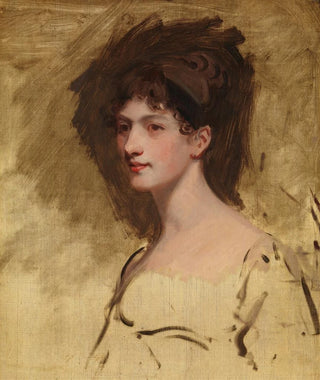Art print | Lady Hester King - John Hoppner


View from behind

Frame (optional)
In the fascinating world of art, some works transcend the mere frame to immerse us in an era, a story, an emotion. "Lady Hester King," painted by John Hoppner, is one of those pieces that captivates the mind and awakens the senses. This portrait, rich in detail and nuance, transports us to 18th-century England, a period marked by social and cultural upheavals. Through this painting, Hoppner does not merely depict a noble lady; he captures the very essence of her character, her social status, and her time. The grace and sophistication emanating from this piece make it a true ode to feminine beauty and the art of portraiture.
Style and uniqueness of the work
John Hoppner's style is distinguished by his ability to combine realism and romanticism. In "Lady Hester King," each brushstroke seems to tell a story, with every shadow and light contributing to the creation of an intimate atmosphere. The delicacy of the features, the richness of the colors, and the thoughtfully orchestrated composition demonstrate exceptional craftsmanship. Hoppner excels in rendering textures, whether it be the luxurious fabrics dressing his model or the luminosity illuminating her face. Lady Hester's pose, both natural and studied, reveals a psychological depth that invites the viewer to ponder her thoughts and emotions. The work is not limited to a simple visual representation; it becomes a genuine dialogue between the artist, the subject, and the observer.
The artist and his influence
John Hoppner, born in 1758, is one of the most renowned portraitists of his time. Trained in the shadow of great masters, he developed a unique style that allowed him to stand out in a competitive artistic landscape. His career was marked by prestigious commissions, notably from royalty and aristocracy. Hoppner captured the spirit of his era while infusing it with a personal touch. His influence endures beyond his own time, inspiring many artists who seek to blend technique and emotion in their works. The

Matte finish

View from behind

Frame (optional)
In the fascinating world of art, some works transcend the mere frame to immerse us in an era, a story, an emotion. "Lady Hester King," painted by John Hoppner, is one of those pieces that captivates the mind and awakens the senses. This portrait, rich in detail and nuance, transports us to 18th-century England, a period marked by social and cultural upheavals. Through this painting, Hoppner does not merely depict a noble lady; he captures the very essence of her character, her social status, and her time. The grace and sophistication emanating from this piece make it a true ode to feminine beauty and the art of portraiture.
Style and uniqueness of the work
John Hoppner's style is distinguished by his ability to combine realism and romanticism. In "Lady Hester King," each brushstroke seems to tell a story, with every shadow and light contributing to the creation of an intimate atmosphere. The delicacy of the features, the richness of the colors, and the thoughtfully orchestrated composition demonstrate exceptional craftsmanship. Hoppner excels in rendering textures, whether it be the luxurious fabrics dressing his model or the luminosity illuminating her face. Lady Hester's pose, both natural and studied, reveals a psychological depth that invites the viewer to ponder her thoughts and emotions. The work is not limited to a simple visual representation; it becomes a genuine dialogue between the artist, the subject, and the observer.
The artist and his influence
John Hoppner, born in 1758, is one of the most renowned portraitists of his time. Trained in the shadow of great masters, he developed a unique style that allowed him to stand out in a competitive artistic landscape. His career was marked by prestigious commissions, notably from royalty and aristocracy. Hoppner captured the spirit of his era while infusing it with a personal touch. His influence endures beyond his own time, inspiring many artists who seek to blend technique and emotion in their works. The






